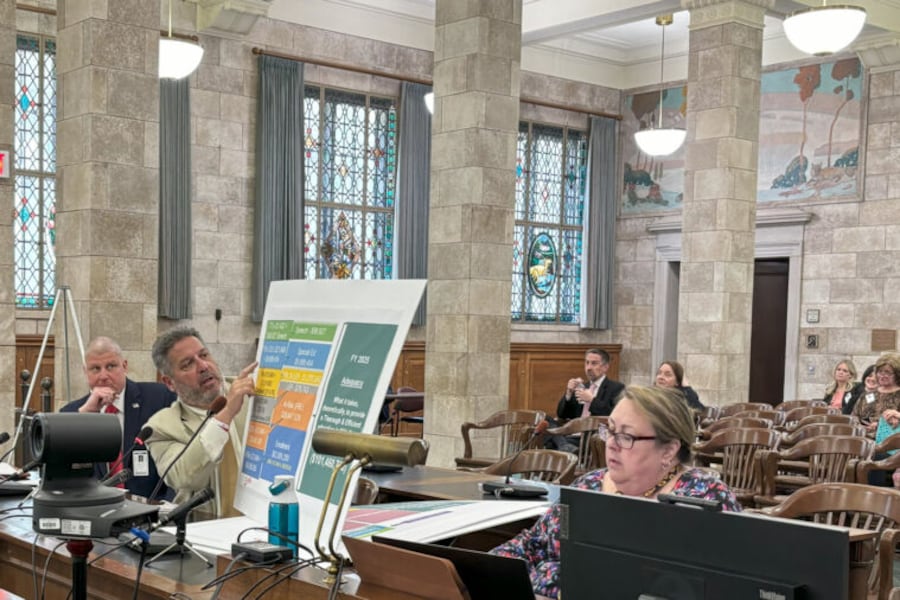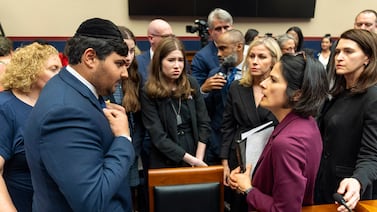Sign up for Chalkbeat Newark’s free newsletter to keep up with the city’s public school system.
For more than three hours, school superintendents and leaders of key education groups lined up one after the other last week to tell lawmakers there need to be significant changes to how schools are funded in New Jersey.
Speakers proposed a wide variety of changes for the Legislature to consider, from raising the cap on property-tax increases to changing how special education funding is calculated. A big target was the state’s school funding formula that calculates how nearly $12 billion in state aid is distributed to schools.
But while there was general agreement in the Senate Education Committee room on March 14 about the problems at hand, what happens next was less certain.
One proposed next step was to create a task force or commission to study the formula and propose recommendations, a lengthy process.
But first, the senators, several of whom missed part of the hearing, said they need to digest the hours of verbal testimony, not to mention written comments from some of the 60 superintendents who requested to appear but were not invited due to time constraints.
“It’s critical we start taking the steps to modernize the formula,” said state Sen. Vin Gopal (D-Monmouth), chair of the committee.
He noted, for instance, that special education and mental health services are now taking up a far larger portion of school budgets than ever before.
“The core of the formula established under the 2008 [School Funding Reform Act] has not changed since the legislation was signed into law, while New Jersey has changed dramatically since 2008,” he said.
Potential cuts in staffing loom for some districts
Gov. Phil Murphy and the Legislature’s Democratic leadership agreed six years ago to fully fund the formula for the first time, leading to around $3 billion in new state aid over that time, culminating in the fiscal year that begins in July.
But in doing so, the formula has brought different results for different districts. A majority of districts have seen significant gains in state aid, but others have faced dramatic cuts.
Superintendents said this volatility from year to year makes it difficult to support students, staff and essential school programs.
“The state sets expectations on students’ performance but doesn’t provide the necessary funding for us to meet them,” said Thomas Farrell of Brick Township. Major reductions in state aid have made it difficult to support the district’s growing population of English language learners, he noted.
In Gopal’s legislative district, Long Branch gained $600,000 in the current fiscal year but is slated to lose $10 million in fiscal year 2025. The school system must submit its budget next week, giving leaders about three weeks to determine how to trim $10 million.
“The impact of [the 2008 reform] has been incredibly uneven among districts,” Gopal said. “It’s also forced a significant portion of the state’s districts to wrestle with unsustainable fiscal volatility.”
Long Branch Superintendent Francisco Rodriguez said everything is on the table for cuts. Class sizes will increase and there will be layoffs, he said. Other superintendents facing cuts said the same.
District leaders seek legislative relief
Gopal and state Sen. Andrew Zwicker (D-Middlesex) on March 18 introduced a bill that would restore 100% of aid — or about $100 million — to school districts facing cuts under Murphy’s latest proposed state budget for fiscal 2025.
The measure is similar to one that restored 66% of aid to districts in the form of supplementary stabilization aid last year. Zwicker said the bill needs to move quickly before districts start cutting programs or laying off staff.
The two senators have also introduced legislation that would raise the 2% cap on how much property taxes can be raised without voter approval in districts facing aid cuts. In fiscal year 2024, 46 districts lost more funding than they were allowed to make up for in local taxes, according to the state School Boards Association. The legislation appeared to have widespread support among speakers at the hearing.
Speakers also suggested a multiyear rolling average of property-tax values be used to calculate local fair share rather than data from a single year to limit volatility. Under the existing formula, the local fair share is combined with state aid to make the so-called adequacy budget for each district. That is the amount of money deemed to be required to provide each student with a “thorough and efficient” education, as demanded by the state’s Constitution.
Jesse Young, the School Boards Association’s legislative advocate, said one-year changes in property values can have dramatic impacts on a district’s state aid. In fiscal year 2021, 21 school districts saw an increase in their equalized valuation of 10% or more. For this year, the number was 322 districts.
River Edge’s interim superintendent, Matthew Murphy, suggested an online calculator to help districts forecast gains and losses in state aid. He and other superintendents also said the budget calendar should be revised so districts have more time between the governor’s budget address in February and when budgets must be submitted in March.
School business administrators said they have about three weeks to prepare their budgets, often grappling with state aid amounts that are significantly different from what they anticipated.
Proposals to factor fluctuating needs
Speakers also emphasized the changes in school operations since the formula became law 15 years ago, such as increased costs for security and mental health. Young said increased security costs, especially for high schools, should be factored into the formula.
Susan Young, executive director of the state Association of School Business Officers, said that while the governor proposed to fully fund the main bucket of equalization aid for general education, other costs — such as special education aid, extraordinary aid, and security aid — are not fully funded.
Special education funding is perennially contentious, and many speakers called for the state to move away from its current census-based method for estimating the number of special education students. The process bases funding on an average percent of special education students, not the exact number of special education students in each district.
This means that some districts receive more money than they need, while others do not receive enough, advocates said. Julie Borst, executive director of the Save Our Schools advocacy group, suggested a tiered system with different weights for different disabilities.
Danielle Farrie, research director at the Education Law Center, the legal advocacy group that has carried the Abbott v. Burke litigation that led to the current funding formula, came with several suggestions.
She said creating floors and ceilings for changes in state aid would reduce volatility and make it easier for school districts to create their budgets. This is already happening in many other states, she said.
Farrie also called for the formula to be reviewed every few years, as required under the law. She proposed a $1 million to $2 million appropriation in the fiscal year 2025 budget for such a review.
Whatever happens next, superintendents asked to be included.
“Moving forward, if you want, form a committee: senators and assembly, bipartisan,” said Scott Feder of South Brunswick. “And please include the people on the ground, and of course, the experts that are here today.”
Hannah Gross covers education and child welfare for NJ Spotlight News via a partnership with Report for America. She covers the full spectrum of education and children’s services in New Jersey and looks especially through the lens of equity and opportunity. This story was first published on NJ Spotlight News, a content partner of Chalkbeat Newark.






